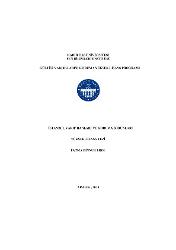| dc.contributor.advisor | Erkan Kösebay, Yonca | en_US |
| dc.contributor.author | Erol, Fatma Binnur | |
| dc.date.accessioned | 2019-07-12T08:37:06Z | en_US |
| dc.date.available | 2019-07-12T08:37:06Z | en_US |
| dc.date.issued | 2013 | en_US |
| dc.identifier.uri | https://hdl.handle.net/20.500.12469/2112 | |
| dc.description.abstract | Orta Asya’dan baslayarak Osmanli İmparatorlugu topraklarinda geliserek yayginlasan vakif kurma anlayisi bircok alanda oldugu gibi mimaride de etkili olmustur. Vakif anlayisi ile insa edilen hanlar kent dokusunda onemli yapilar olmuslardir. Han mimarisi ticari gelismeler ve ihtiyaclar dogrultusunda sekillenerek 19.yy.’a kadar gelismistir. Vakif hanlar 19.yy.’in sonunda İstanbul’da Evkaf Nezareti gunumuzdeki adi ile Vakiflar Genel Mudurlugu tarafindan donemin modern malzemeleri ile bir dizi halinde tasarlanarak insa edilmistir. Cumhuriyet doneminde de insasina devam edilen bu yapilar Vakiflar Genel Mudurlugu’ne gelir getirmek uzere yapilmistir. Teknolojik gelismelerin etkisi ile birlikte klasik han mimarisinden farkli olarak gelismis gecmisin sade han yapilarinin yerine adeta cephenin ozellikle bezemelerle donatildigi yeni bir uslupla yapilmistir. Bircogu ticaret fonksiyonunun yuksek oldugu Eminonu ve Karakoy’de oda bazinda kiralanmak uzere ticarethane olarak insa edilmistir. Vakif hanlar konut ve yatakhane islevleri ile Ýstanbul’un Beyoglu ve sehzadebasi semtlerinde de karsimiza cikmaktadir. Bu calismada cesitli donemlerde insa edilen farkliliklari ve benzerlikleri icinde barindiran yedi vakif hanin mimari ozellikleri incelenmistir. Vakif hanlardan bir kismi gunumuzde Vakiflar Genel Mudurlugu tarafindan Restore Et-İslet-Devret ve sistemi ile restore edilerek islev degisikligine ugramis turizm sektorunde otel olarak hizmet vermeye baslamistir. Ancak soz konusu vakif hanlarda koruma kapsaminda yapisal cevresel ve yeniden islevlendirmeye dayali sorunlarla karsilasilmaktadir. Yapilan tespit ve belgeleme yontemleri sonucunda vakif hanlarinin mimari degerleri goz onune alinarak onerilerde bulunulmustur. | en_US |
| dc.description.abstract | The idea of establishing foundations, initially emergedat the central asia and later became widespread in the lands of the Ottoman Empire , has affected many areas including architecture. Inns built as a pious foundation have become important buildings in urban fabric (ne zaman). Inn architecture is developed through the needs of the society and evolved till 19th century. "Vakif Hanlar" has been constructed in a series with contemporary materials by the Ottoman Ministry of Foundations "Evkaf Nezareti" toward the end of 19th century and has been constructed also in the republican period in orderto create income for the ministry. With the aid of technological improvements, these inns acquired a different character instead of using classical inn architectural style, the facades were especially decorated with adornments. Many of the "Vakıf Hanlar" were built as offices to rent out in Eminönü and Karaköy, where the commercial capacity is high. We also come across with "Vakıf Han"s in Beyoğlu and Şehzadebaşı with different uses. In this thesis, 7 of the "Vakıf Han", , are studied according to their building plans, construction systems and facades. Some of the "Vakıf Han" is renovated according to restore-operate-transfer and they are being used as hotels in the tourism industry. However, some problems are being experienced in terms of structural, environmental and re-use. In this thesis, some suggestions are provided according to the architectural value of "Vakıf Han"s . | en_US |
| dc.language.iso | tur | en_US |
| dc.publisher | Kadir Has Üniversitesi | en_US |
| dc.rights | info:eu-repo/semantics/openAccess | en_US |
| dc.subject | N/A | en_US |
| dc.title | İstanbul vakif hanlari ve koruma sorunlari | en_US |
| dc.type | masterThesis | en_US |
| dc.department | Enstitüler, Lisansüstü Eğitim Enstitüsü, Kültür Varlıklarını Koruma Ana Bilim Dalı | en_US |
| dc.relation.publicationcategory | Tez | en_US |
| dc.identifier.yoktezid | 352260 | en_US |
















